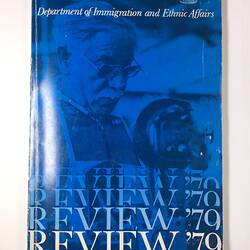Summary
Book, titled 'Department of Immigration and Ethnic Affairs Review of Activities to 30 June 1979', published by Australian Government Publishing Service, Canberra 1979.
This annual report includes a well-known photograph (p.14) showing Australian Immigation Officer, Steve Carter interviewing Vietnamese refugees with an unnamed interpreter, 'at an island camp, off the east coast of peninsula Malaysia during1978-79'. The photograph was choreographed and actually taken at Belfield camp, Kuala Lumpur, not on the east coast as captioned. At the time Stephen was working mostly on the east coast of Malayia and travelled by fishing boat from Mersing to Pulau Tengah camp and from Kuala Terengganu to Pulau Bidong. The caption of the photo records that Steve slept on the interviewing table at night. Stephen notes that he had to 'shave and scrub up' for that photo [email SC to McFadzean 24/1/2024].
Stephen worked for the Department of Immigration from 1965-1996 and was based in Malaysia and Thailand after the Vietnam War, attached to the Indochinese Refugee Taskforce during 1978-79. He spent six weeks in Thailand and 14 months in Malaysia interviewing Vietnamese refugees on Pulau Tengah and Pulau Bidong islands, and Kuantan city (Malaysia) and Tanjong Pinang (Indonesia).
Stephen purchased two pen and ink drawings that were created by Trieu Nhan Vinh, a Vietnamese refugee artist who was in transit to Australia. Stephen had the drawings framed while in Kuala Lumpur and they accompany this book in Museums Victoria's Collection.
Physical Description
A B5-size book of 96 numbered pages plus front matter, in a portait format, with soft card covers and 'perfect' binding. The covers are printed in cerulean blue with a photograph of an elderly man superimposed with text in white. The book text is printed in black on white paper and accompanied by numerous black and white photos and diagrams.
Significance
These items add to the Museum's growing collection representing two sides of the asylum experience - the refugees and the government officials. These parallel and intersecting experiences have both personal and bureaucratic elements to them, linked by place, and world events, with craft and gifts of appreciation providing tangible points of connection and memory.
The experiences of migration officials are frequently untold and unrepresented by material culture, as are material manifestations of refugee narratives. This collection enables the telling of both stories, with primacy given in this instance to the immigration process worker as custodian of the objects. The overall collection is also a symbol of a particular period in Australian migration history when support for refugee programs had both bipartisan and public support.
The theme of refugee, internee and detainee craft recurs across time and place and provides a tangible connection between very different human experiences, the trauma, economy, creativity and the tedium of which has been consistently alleviated through artistic practice.
The Migration collection is developing a strong collection relating to the personal experiences of Australian migration officials across time. In terms of the post Vietnam War period, this material from Stephen Carter enhances such collections as Jenny Roberts Indo-China Refugee Worker Collection of camp craft and photographs; the Lachlan Kennedy immigration processing worker boat models and photographs; and the Tim Baker Kuantan refugee arrivals photographs.
The collection also connect themes of refugee and internee experiences across time through the Esma Banner World War II Displaced Person processing worker collection and the Tyldesley Displaced Persons photographic collection; while material relating to Dept of Immigration post-WWII migration ocean liner welfare officers Margaret Woods and Noreen Leen expands the different kinds of employment was undertaken by Australians during this period of mass migration.
More Information
-
Collecting Areas
-
Previous Owner
Mr Stephen Carter, Canberra, Australian Capital Territory, Australia, 1979
-
Inscriptions
Front cover: 'Department of Immigration and Ethnic Affairs / REVIEW '79'
-
Classification
Migration, Processing - immigration selection, Refugee camps
-
Category
-
Discipline
-
Type of item
-
Overall Dimensions
176 mm (Width), 8 mm (Depth), 250 mm (Height)
-
Keywords
Vietnamese Immigration, Refugees, Annual Reports, Immigration Selection, Immigration Policies, Government Workers, Government Departments



